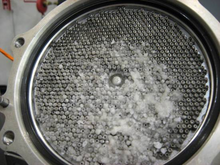Rolls-Royce Trent 800
| Trent 800 | |
|---|---|

| |
| Rolls-Royce Trent 800 on a British Airways 777 | |
| Type | Turbofan |
| Manufacturer | Rolls-Royce plc |
| First run | September Template:Avyear |
| Major applications | Boeing 777 |
The Rolls-Royce Trent 800 is a high-bypass-ratio turbofan engine, developed from the RB211 and is one of the family of Trent engines. It was designed to be used on the Boeing 777.
Design and development
In the late 1980s, Boeing was investigating an enlarged development of its 767 model dubbed the 767X, for which Rolls-Royce proposed the Trent 760. By 1990 Boeing abandoned its planned 767X and instead decided to launch a new, larger aircraft family designated 777 with a thrust requirement of 80,000 lbf (360 kN) or more. The Trent 700's 2.47 m (97 in) diameter fan would not be big enough to meet this requirement, so Rolls proposed a new version with a 2.80 m (110 in) fan diameter, designated Trent 800. Rolls brought in Kawasaki Heavy Industries and Ishikawajima-Harima Heavy Industries as risk and revenue sharing partners who between them took an 11 per cent stake in the Trent 700 and 800 programmes.[1]
Testing of the Trent 800 began in September 1993, and certification was achieved in January 1995.[2] The first Boeing 777 with Trent 800 engines flew in May 1995, and entered service with Thai Airways International on 31 March 1996.[3] 180 minutes ETOPS approval was granted by the FAA on 10 October 1996.[4]
Initially Rolls-Royce had difficulty selling the engine: British Airways, traditionally a Rolls-Royce customer, submitted a large order for the competing General Electric GE90 engine. The breakthrough came when the company won orders from Singapore Airlines, previously a staunch Pratt & Whitney customer, for its 34 Boeing 777s; this was soon followed by large North American orders from American Airlines and Delta Air Lines for their 777 fleets. British Airways announced in September 1998 that it was returning to Rolls-Royce for its second batch of 777s, and did so again in April 2007. The Trent 800 has a 41% share of the engine market on the 777 variants for which it is available. Rolls-Royce Trent 800s are now commonly used on the Boeing 777 series. Major airlines such as Air New Zealand, British Airways, American Airlines, Kenya Airways, Emirates, and many other airlines now operate Boeing 777's with Trent 800s on a regular schedule.[5]
Accidents and incidents

On 17 January 2008, a British Airways Boeing 777-236ER, operating as flight number BA038 from Beijing to London, crash-landed at Heathrow after both Trent 800 engines lost power during the aircraft's final approach. The subsequent investigation found that the cause was ice released from the fuel system which accumulated on the fuel-oil heat exchanger leading to a restriction of fuel flow to the engines.[7] Rolls-Royce has developed a modification to prevent the problem recurring.[8]
Applications
The Trent 800 family powers the Boeing 777. It is available on the 777-200, 777-200ER and 777-300 variants, with thrust ratings spanning 75,000 to 93,400 lbf (334 to 415 kN). The engine is one of the lightest in its class; a Trent-powered Boeing 777 weighs up to 3.6 tonnes less than General Electric and Pratt & Whitney-powered versions.
The Trent 800, however, is not available on the longer-range and freighter 777 variants ( 777-200LR, 777-200 Freighter and 777-300ER); these variants are exclusively powered by the GE90-115B (110B1) engine.
Specifications (Trent 800)
General characteristics
- Type: Three-shaft high bypass ratio (6.2-5.7) turbofan engine
- Length: 4.37 m (172 in)
- Diameter: 2.79 m (110 in)
- Dry weight:
Components
- Compressor: Eight-stage IP compressor, six-stage HP compressor
- Combustors: Single annular combustor with 24 fuel injectors
- Turbine: Single-stage HP turbine, single-stage IP turbine, five-stage LP turbine
Performance
- Maximum thrust: 93,400 lbf (415 kN)
See also
Related lists
References
Notes
- ^ "Powerful partner in Japan". Retrieved 2007-02-02.
- ^ "Aero-Engines - Rolls-Royce Trent". Jane's. February 13, 2001. Archived from the original on 2007-11-10. Retrieved 2007-07-26.
- ^ "Boeing 777".
- ^ "Chronology Of The Boeing 777 Program". Archived from the original on 2007-06-09. Retrieved 2007-07-26.
- ^ "Rolls-Royce Trent 800". Retrieved 2009-02-15.
- ^ "Safety Recommendation: In reply refer to: A-09-17 (Urgent) and -18" (PDF). National Transportation Safety Board. March 11, 2009.
- ^ "Rolls-Royce to modify Trent as tests replicate BA 777 icing". Flight International. March 12, 2009. Retrieved 2009-03-15.
- ^ "Rolls-Royce: Trent 800 fix only part of broader icing issue". Flight International. March 12, 2009. Retrieved 2009-03-15.
0
External links
| This aircraft engine article is missing some (or all) of its specifications. If you have a source, you can help Wikipedia by adding them. |
